How to fix an oil spill
Three accidents involving oil tankers over the past week caused massive traffic jams as roads and expressways had to be closed for hours.
We look at how oil spills are cleared
SCDF FLUSHES SPILL
The Singapore Civil Defence Force (SCDF) is typically the first responder after an oil spill on the roads.
An SCDF spokesman said: "For a typical oil spill incident in which there is no fire and no one is trapped or injured, in view of safety to road users, SCDF will proceed to the incident site to assist the National Environment Agency (NEA) and Land Transport Authority (LTA) with the clean-up operation by using water jets and bio-solvents to flush away the oil spill.

"Subsequently, SCDF hands over the incident to NEA and LTA upon their arrival and puts its resources back on standby for emergency response."
SCDF hands over to NEA and LTA for further cleaning if there is more of the spill to clear.

NEA CLEANS UP SPILL
An NEA spokesman said: "For oil spill incidents on public roads and expressways, the NEA dispatches its service provider to the site to clean up the spill to assist in restoring the situation to normalcy."

After the extensive palm oil spill on the Bukit Timah Expressway last week, an NEA spokesman said it used absorbent pads and oil booms to contain the spread of the spill.
In cases where the spill is extensive, NEA hands over the operation to LTA.
LTA RESURFACES ROAD
After the clean-up, LTA is in charge of resurfacing the roads and assessing if they are safe for reopening.
Resurfacing is required because the oil spill could leave a slippery coating on the road or the tarmac could have softened after contact with oil, said Mr Joe Eades, deputy chairman of the chemical and process engineering technical committee at The Institution of Engineers.

Palm oil, diesel and an unidentified substance were reportedly leaked on the roads over the past few days.
"In the case of the palm oil, there was no risk other than the slippery surface of the road as palm oil, being a vegetable oil, is non-flammable and non-toxic," said Mr Eades.
"In the case of the diesel, the oil spill would soften the road surface, making it necessary for the road to be resurfaced."
Drivers need to do defensive driving
Consultancy firm Safety@Work's director Raj Singh said congestion on roads and poor road user behaviour could be possible reasons for the spate of accidents.
He added that drivers of oil tankers usually have to go through training for handling hazardous materials.
"They also need to learn defensive driving and be prepared to handle emergencies."
But aspects such as vehicle and journey management are also important, said Mr Raj.
"Companies have to make sure that the vehicle is well-maintained. The drivers should also plan their routes well and avoid congested roads as much as possible."
He said that some tankers come with spill kits, which allows drivers to deal with minor spills
Aside from the inconvenience caused by traffic jams, oil spills can also pose risks to commuters, said Mr Joe Eades, deputy chairman of The Institution of Engineers's chemical and process engineering technical committee."It is important that the public be patient during such incidents and keep a safe distance to allow the emergency services to do their job," he said.
Get The New Paper on your phone with the free TNP app. Download from the Apple App Store or Google Play Store now





